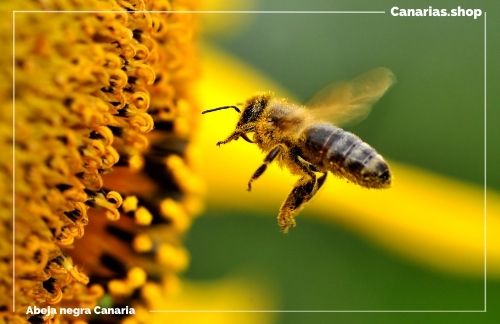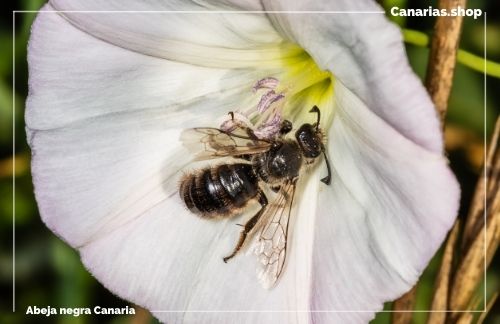Canarian black bee
The Canarian black bee is a unique species of the islands, which participates directly in the production of various types of honey in the archipelago and has special characteristics that have maintained it over the years.
What is the Canarian black bee like?
Without a doubt it is a very particular species and that has an origin that dates back more than 200,000 years ago. The Canarian bee can be said to be a descendant of several species of African bees, what were developed in the south of the Iberian Peninsula and that little by little they were acquiring special and particular characteristics that made it a unique breed.
Among the main characteristics of the Canarian black bee is its special behavior, which is not aggressive, which has allowed beekeepers of the Islands to develop their production activity with greater freedom in this area.

In addition to this, the Canarian black bee has a great capacity for adaptation, since the Islands have a variant climate and an endemic flora that does not suit some species but that for the black bee has been of great benefit for its reproduction and for the production of different types of honeys.
As for physical characteristics, the Canary black bees can usually measure 22 mm, they have the body covered with a kind of hairs arranged in the form of a band and tawny color, except in the abdomen.
In the posterior tibias they have curved hairs that serve to support the pollen while transporting it.

The Canarian black bees have an exceptional organization, their hives are distributed in ranges, where the queen bee is of course the one with the longest life. It can live a total of 3 years and is responsible for reproduction.
There are also the drones that are the males of the hive and are only responsible for fertilizing the queen, these do not have a stinger.
The last classification in the hive is for worker bees, they are the ones that live the least but do the most work. These are responsible for the construction of the hive, seal the cells for the time of reproduction and feed the larvae, they can live only 3 months.

Where it is distributed
Although the species is native to the Canary Islands, over the years it has been endangered thanks to the arrival of other species with which they mixed forming hybrids of the breeds, with different characteristics.
That is why, the Government of the Canary Islands decided to carry out a plan of conservation, recovery and selection of the breed to maintain its original character and reproduce them correctly.
If you like honey, you can find here a selection of honey from the Canary Islands
Based on this, the government of the Canary Islands has promoted selective beekeeping activity, distributing the breed throughout the Canary archipelago.
This has benefited not only the conservation of the breed, but also the production of different types of honey that occur on each of the islands.
On the other hand, in this same plan of conservation of the Canarian black bee by the government of the islands, it has also been in charge since 2001 of distributing the breed in some of the countries that practice beekeeping.

Habitat of the Canarian black bee
The habitat of the Canarian black bees is one of the most wonderful and surprising aspects of this species, mainly due to the complexity of the construction of the hives.
But especially because in the case of the Canary Islands, these can even inhabit areas with volcanic characteristics and different climates, which show us their great capacity for adaptation.
The hives of these small producers are built by the worker bees, which make two types of cells, vertical ones for the larvae that become pupa. In this process, the workers are in charge of sealing the cells.
There are also horizontal cells where the workers live, while the queen bee will always live in a much wider cell and in an upright position.

Diet and reproduction of the Canarian black bee
The feeding of the bees is also classified, and is that depending on the range of the bee will also vary its feeding. It is not that there is some kind of discrimination in them, but because their characteristics and functions demand that their diet be different.
Most bees in the hive will feed on nectar from flowers or pollen, but this only after 3 days, since before this period (in which they are still larvae) both worker bees and queens feed on royal jelly.
If you like honey, you can find here a selection of the best honey from the Canary Islands
After 3 days, they will divide and only queen bees will feed on royal jelly. All others will eat pollen, nectar or diluted honey.
Reproduction
Reproduction is also very curious, since only queen bees can be fertilized, they copulate in mid-flight, with more than 15 males, called drones.
Once fertilized, the queens lay the eggs in the hives where after 3 days the larvae of the eggs come out, who in a week will become pupa, while they are fed by nurse bees.
After a week they will have developed enough to become adult bees.

5 curiosities of the Canarian black bee
As you can see, there are many attributes of this wonderful species, which has a much more structured form of reproduction and organization than any human institution. So before closing this article, we want to leave you some curiosities of the Canarian black bee that will leave you surprised:
It is one of the most meek species and without aggressive traits known worldwide.
It is an endemic species, that is, it was originally produced in the Canary Islands.
The Canarian black bees are mainly responsible for pollination on the islands and the production of honeys native to the archipelago.
What makes them different from other breeds are their unique haplots, which other types of bees do not possess.
Although they were in danger of extinction for a time due to hybridization with other breeds, today the original characteristics of the breed have been fully recovered and have been introduced in various parts of the world to promote their conservation and reproduction.
